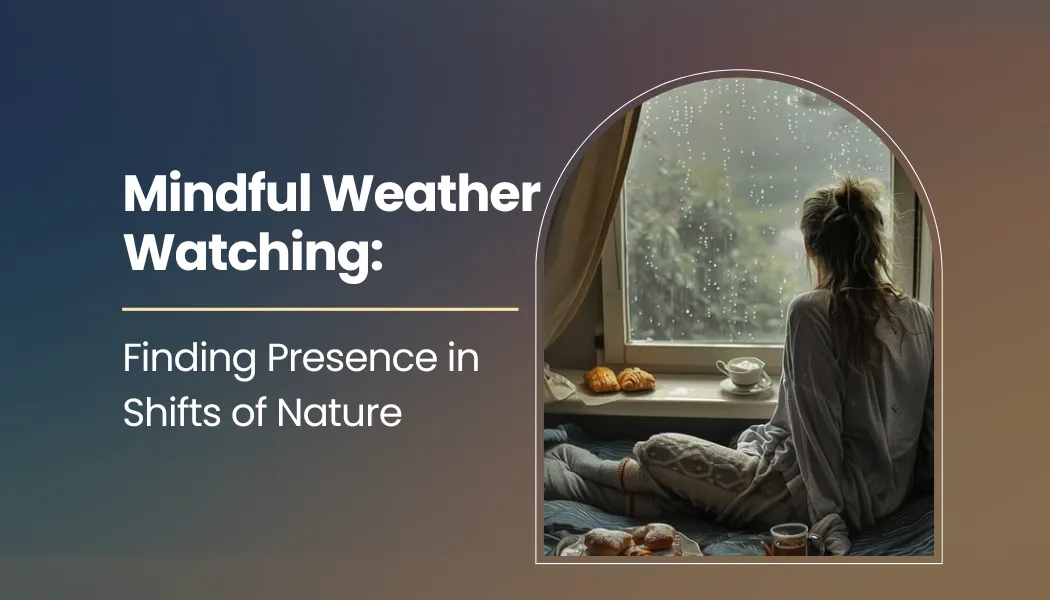We often rush through our days without noticing the world above our heads. Yet, the sky is always moving, always teaching. Clouds drift, winds shift, rain falls, and sunlight returns—all reminding us that change is the only constant. Mindful weather watching is the practice of slowing down, paying attention, and connecting with these natural rhythms. It transforms ordinary forecasts into opportunities for presence and reflection.
This article explores how weather can become a mindfulness practice, how paying attention to natural shifts enriches memory and mood, and why reconnecting with the sky may be one of the simplest ways to cultivate presence in a distracted world.
Table of contents
- Why Weather Watching Matters
- The Science of Mindful Attention and Nature
- Weather as a Mirror of Mind
- The Practice of Mindful Weather Watching
- Weather Across the Seasons: A Mindful Journey
- Weather Watching and Memory
- The Role of Ritual
- Weather and Collective Presence
- Modern Life and Disconnection from Weather
- Healing Through Weather Awareness
- A Global Perspective: Weather Mindfulness Across Cultures
- Tips to Begin Your Practice
- Conclusion: Presence in Every Shift
Why Weather Watching Matters
Weather is universal. Everyone experiences it—whether a humid summer afternoon, a sudden thunderstorm, or the crisp stillness of winter air. But while weather is constant, our relationship with it has changed.
- Past generations relied on weather cues for farming, travel, and survival.
- Modern life often reduces weather to an inconvenience or a notification on a phone app.
Mindful weather watching invites us back into relationship with the elements. It’s not about predicting storms or reading barometers. It’s about noticing sensations, colors, patterns, and moods. By doing so, we reawaken a sense of wonder that modern routines often dull.
The Science of Mindful Attention and Nature
Neuroscience shows that attention is like a muscle—the more we practice directing it, the stronger it becomes. Weather offers a perfect focal point: shifting clouds, the feel of wind, the smell of rain.
Studies have shown that:
- Nature reduces stress – Exposure to natural patterns lowers cortisol and blood pressure.
- Attention improves memory – The act of paying deliberate attention strengthens how experiences are stored.
- Mindfulness enhances mood – Being present with simple phenomena, like changing weather, interrupts cycles of overthinking.
When we watch weather with presence, we engage multiple senses, calm the nervous system, and anchor memory in the richness of experience.
Weather as a Mirror of Mind
Weather and emotions are deeply intertwined. We describe moods as “stormy,” “sunny,” or “clouded.” This metaphorical link makes weather a natural mindfulness ally.

- Sunny skies can invite gratitude and lightness.
- Rain can become a lesson in cleansing and release.
- Storms can remind us of the power of impermanence—fury followed by calm.
- Snow may symbolize stillness and quiet reflection.
By noticing these parallels, we learn to observe emotions with the same openness we bring to weather—acknowledging them without judgment, knowing they too will pass.
The Practice of Mindful Weather Watching
Here’s how anyone can start:
1. Step Outside With Intention
Instead of rushing from one place to another, pause. Feel the temperature, notice the quality of the air, and sense how your body responds.
2. Observe the Sky
Look up. What colors are present? Are clouds thick, wispy, or fast-moving? Is there a sense of heaviness or openness in the sky?
3. Engage the Senses
- What does the wind feel like on your skin?
- Can you smell rain, flowers, or earth?
- What sounds accompany the weather—birds, rustling leaves, thunder?
4. Notice Emotional Resonance
Ask yourself: how does this weather affect my mood? Do I feel energized, calm, restless, or contemplative?
5. Journal or Reflect
A short entry about the weather each day becomes a record not just of climate but of presence—tying external shifts to internal states.
Weather Across the Seasons: A Mindful Journey
Spring – Renewal and Attention to Detail
Spring invites us to notice transitions: the first blossoms, shifting light, gentle rains. Mindfulness here means savoring beginnings and honoring patience.
Summer – Energy and Expansion
Warmth and long days encourage vitality but also restlessness. Mindful weather watching helps us balance activity with cooling pauses—finding calm beneath the heat.
Autumn – Letting Go
Falling leaves and crisp winds symbolize release. By observing weather in autumn, we practice acceptance and gratitude for cycles of change.
Winter – Stillness and Reflection
Snow, frost, and long nights draw us inward. Winter’s weather teaches us to embrace silence, conserve energy, and honor rest as part of growth.
Weather Watching and Memory
Mindful weather observation also strengthens memory. When we anchor experiences to sensory weather cues, recall becomes more vivid.
For example:
- “I remember that conversation—it was just as the first snow fell.”
- “I’ll never forget that morning; the sunrise painted the sky with orange and violet.”
These connections make memories richer, embedding them in the sensory fabric of nature.
The Role of Ritual
Turning weather watching into a ritual gives rhythm to mindfulness. Some ideas include:
- Morning sky check – Begin each day by noticing the horizon.
- Rain meditation – Listen attentively to rainfall, allowing it to soothe the mind.
- Seasonal walks – Walk the same path monthly, noting changes in light, color, and air.
These small rituals remind us that mindfulness need not be complicated—it can be as simple as looking out the window with awareness.
Weather and Collective Presence
Weather isn’t only personal—it’s shared. Entire communities experience storms, droughts, and sunshine together.
Practicing mindful weather watching collectively can:
- Deepen conversations—“Did you notice the colors in last night’s sunset?”
- Create shared gratitude—celebrating the first rains after drought.
- Build resilience—facing natural challenges with awareness rather than fear.
In this way, mindful weather watching strengthens not just individual presence, but community bonds.
Modern Life and Disconnection from Weather
Today, weather is often reduced to a forecast notification: “Rain tomorrow, 40% chance.” While useful, this efficiency disconnects us from the lived reality of the elements.
- Climate-controlled homes and cars shelter us from sensations.
- Busy schedules discourage pausing to notice.
- Constant digital focus leaves little room for natural rhythms.

Mindful weather watching restores this connection. It reminds us we’re part of the same systems that govern tides, seasons, and skies.
Healing Through Weather Awareness
For those dealing with stress, grief, or anxiety, weather watching can be deeply healing. The steady rhythm of nature offers comfort in its reliability: storms come, storms go, and skies clear again.
Therapists sometimes integrate weather imagery in mindfulness exercises, guiding people to see emotions as clouds drifting across the sky—present but impermanent. This metaphor, practiced in real-time through weather watching, fosters resilience and calm.
A Global Perspective: Weather Mindfulness Across Cultures
Different cultures have long traditions of weather observation:
- Japanese haiku often celebrate fleeting weather moments like rain showers or snow.
- Indigenous communities read skies and winds as part of daily life, blending survival with reverence.
- Poets worldwide use weather as metaphor for inner states.
Mindful weather watching aligns us with this timeless human practice—finding meaning in the sky’s shifting moods.
Tips to Begin Your Practice
- Keep a weather journal – Note the day’s sky and how it made you feel.
- Photograph skies – Capture the same view at different times, noticing change.
- Practice gratitude – End your day by thanking the weather, whatever it was, for its lessons.
- Pair with breathwork – Sync your breathing with wind or rainfall patterns.
- Observe transitions – Pay attention at dawn, dusk, or during storms—the times when change is most visible.
Conclusion: Presence in Every Shift
Mindful weather watching is about more than appreciating clouds or rain. It’s about slowing down, grounding ourselves, and remembering that we are part of something larger.
Every gust of wind, every patch of sunlight, every storm teaches impermanence, resilience, and renewal. When we cultivate presence with these shifts, we not only deepen mindfulness but also enrich memory, mood, and meaning.
The next time you step outside, pause. Look up. Feel the air. Notice the sky. In that moment, you are practicing mindfulness. You are remembering what it means to be alive.
